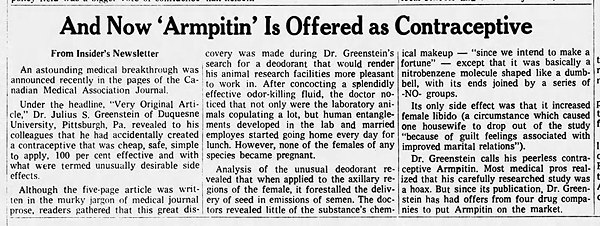Satire
Two by Steve Cutts
The creator's Wikipedia page.
Posted By: Paul - Tue Nov 26, 2024 -
Comments (0)
Category: Anthropomorphism, Business, Shopping, Cartoons, Satire
Mystery Flesh Pit National Park
Located near Gumption, Texas, the Mystery Flesh Pit National Park is a must-see for all curiosity-seekers.
Of course, it's an elaborate satire. A mash-up of upbeat National Park merchandising and Lovecraftian horror. But apparently not everyone realizes that. Its creator, artist Trevor Roberts, reports:
More info: outdoorswire.usatoday.com
Posted By: Alex - Tue Aug 27, 2024 -
Comments (2)
Category: Freaks, Oddities, Quirks of Nature, Satire
AI Pastor
I'm assuming this is satire because the site doesn't actually share any AI-generated spiritual guidance. If you click the "Get Started" button it shows a pop-up that says "coming soon."On the other hand, I wouldn't be surprised if AI could provide online spiritual help on a par with flesh-and-blood pastors.
More info: AI Pastor


Posted By: Alex - Tue Aug 13, 2024 -
Comments (7)
Category: Religion, AI, Robots and Other Automatons, Satire
A brief history of mass-production shaving machines
Around 1780: "An anonymous British printmaker, perhaps from Birmingham, issued a satire of mechanization and factories occuring during the Industrial Revolution, in the form of an imaginery 'New Shaving Machine, whereby a number of persons may be done at the same time with expedition, ease, and safety.'" (text from historyofinformation.com)
Around 1825: "British illustrator and caricaturist Robert Seymour... issued Shaving by Steam... In his creation of this print Seymour was undoubtedly inspired by an earlier anonymous print entitled 'New Shaving Machine.' The sign above the door on the right in Seymour's image announces 'Patent Shavograph!!!'" (text from historyofinformation.com)

Oct 1960: English comedian Eric Sykes built a working "New Shaving Machine" (modeled from the 1780 print) on a pilot show for a proposed television series called 'Brainwaves.' The premise of the show was recreating strange old-time inventions. However, the show never aired.


images source: vintag.es

Lincolnshire Echo - Sep 29, 1960
History via reddit user KBHoleN1
Posted By: Alex - Fri Mar 29, 2024 -
Comments (0)
Category: Technology, Satire
Cold War Coloring Books
AboutComics.com recently released an expanded edition of Cold-War Coloring: Political Adult Coloring Books of the Kennedy Era, and WU played a small part in its creation.The book collects together politically-themed, satirical coloring books of the 1960s. Such as the JFK Coloring Book and Khrushchev’s Top Secret Coloring Book.
For the expanded edition the editor, Nat Gertler, wanted to include the Sing along with Khrushchov coloring book, published in 1962. However, he couldn't find a copy of it. There were no copies in libraries and none for sale.
Then he discovered that we here at WU happened to have posted a scanned copy of it online back in 2020. I tried to connect him with the reader who had sent us the scanned copy, so that he could get a higher-quality version of the pdf, but no luck there. But thankfully Nat was able to make do with the copy we had. So now this obscure title is once again in print.
Glad we were able to help prevent it from being lost forever.

Posted By: Alex - Thu Oct 19, 2023 -
Comments (1)
Category: Politics, Books, 1960s, Satire
Two by Michael Leunig
The creator's Wikipedia page.
Posted By: Paul - Mon Aug 14, 2023 -
Comments (0)
Category: Humor, Satire, Cartoons, Australia
Fish Condos
Joey Skaggs Fish Condos from Joey Skaggs on Vimeo.
Posted By: Paul - Tue Jul 18, 2023 -
Comments (0)
Category: Fish, Satire, Twenty-first Century
Armpitin
Dec 1965: The Canadian Medical Association Journal published a "very original article" detailing the discovery of a new contraceptive called "Armpitin." When women applied it under their armpit, it had the simultaneous effect of increasing female libido and temporarily making men who smelled it sterile.Most readers recognized the article as a joke (even though the journal wasn't known for its humor). However, the author, Julius Greenstein, later reported that he received an inquiry from a French pharmaceutical firm seeking to acquire the patent rights to Armpitin.
You can read Greenstein's full article ("Studies on a New, Peerless Contraceptive Agent: A Preliminary Final Report") here.

Minneapolis Star - Mar 10, 1966
Click to enlarge
Posted By: Alex - Sat May 06, 2023 -
Comments (3)
Category: Medicine, 1960s, Satire
For Carl Andre
For Carl Andre is a 1970 artwork by Lynda Benglis. It consists of a heap of polyurethane foam sitting in the corner of a room. It's owned by the Modern Art Museum of Fort Worth.
The title refers to the sculptor Carl Andre, known for his ultra-minimalist works. For instance, one of Andre's more famous works, Equivalent VIII, consisted of a rectangular stack of bricks. The Fort Worth Art Museum catalog notes:
So it's not "strictly pejorative," but maybe it's slightly so? Or satirical?
Posted By: Alex - Wed Feb 08, 2023 -
Comments (3)
Category: Art, 1970s, Satire
The Humor of Regis Cordic
Wikipedia entry for Regis Cordic.
Posted By: Paul - Wed Apr 27, 2022 -
Comments (0)
Category: Aliens, Humor, Parody, Satire, Inventions, Radio, Advertising, 1950s, 1960s, Alcohol

| Who We Are |
|---|
| Alex Boese Alex is the creator and curator of the Museum of Hoaxes. He's also the author of various weird, non-fiction, science-themed books such as Elephants on Acid and Psychedelic Apes. Paul Di Filippo Paul has been paid to put weird ideas into fictional form for over thirty years, in his career as a noted science fiction writer. He has recently begun blogging on many curious topics with three fellow writers at The Inferior 4+1. Contact Us |




